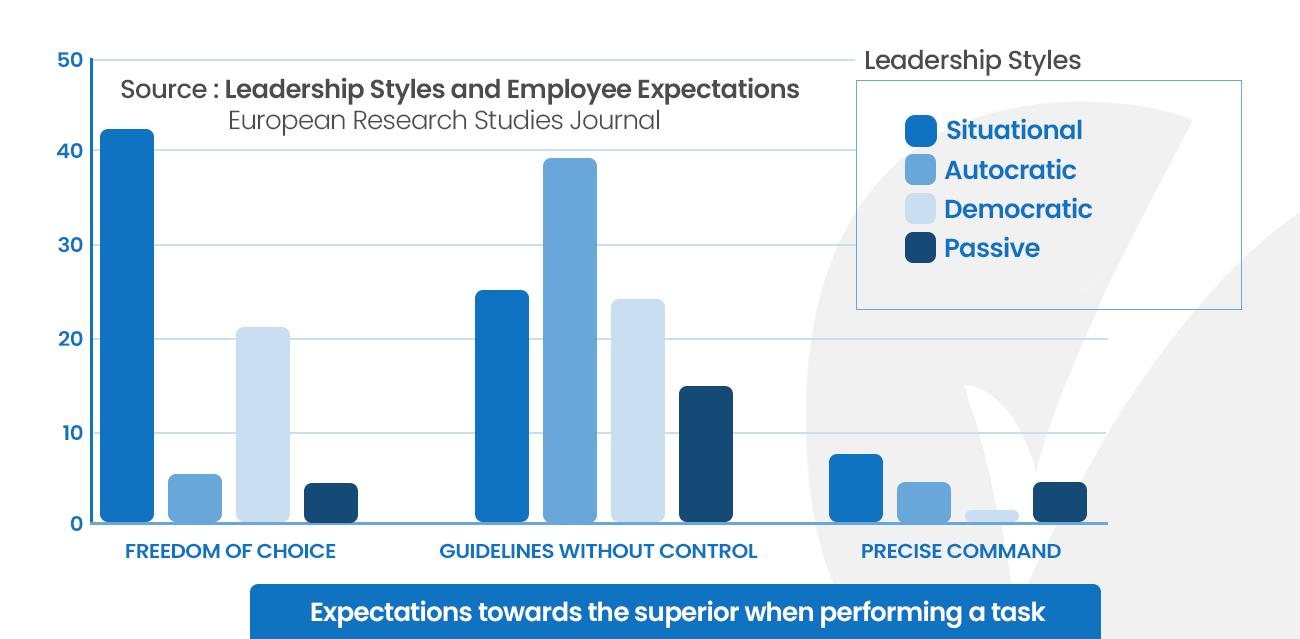What kind of boss are you? In fact, do you consider yourself a boss or a leader? Leadership is gradually gaining momentum, overthrowing the traditional boss figure, who only focuses on business results, as Jack Zenger and Joseph Folkman of Harvard Business Review explain:
“More than three-quarters of leaders (78%) scored higher on their ability to generate results than on their ability to inspire and motivate others.”
For that reason, there is currently a change happening within companies’ organizations, where the incorporation of leaders over bosses is being favored. In this article, we will show you up to 16 leadership styles and which ones are most commonly used.
But what exactly is the difference between a leader and a boss?
Index of contents
- Difference Between a Leader and a Boss
- What is Leadership
- Business Leadership Styles
- 1. Transformational Leadership
- 2. Autocratic Leadership
- 3. Transactional Leadership
- 4. Democratic Leadership
- 5. Laissez-Faire Leadership
- 6. Natural Leadership
- 7. Charismatic leadership
- 8. Bureaucratic leadership
- 9. People-oriented leadership
- 10. Task-oriented leadership
- 11. Curve leadership
- 12. Situational leadership
- 13. Visionary leadership
- 14. Paternalistic leadership
- 15. Strategic leadership
- 16. Leadership with coaching methods
- What are the most commonly used leadership styles?
Difference Between a Leader and a Boss
A boss can be defined as an imposed authority who uses their power to command and order their subordinates, while a leader is one who guides and motivates a team of people without imposing their own ideas. As Russell H. Ewing said:
“A boss creates fear, a leader, confidence. A boss fixes blame, a leader corrects mistakes. A boss knows it all, a leader asks questions. A boss makes work drudgery, a leader makes it interesting.”
Therefore, we could say that the boss has a more traditional vision, based on the actions of commanding and ordering their subordinates. On the other hand, a leader creates and communicates the company’s strategies by motivating and directing work teams.
What is Leadership
Once the difference is clarified, how could we exactly define leadership? Infopédia dictionary defines it as “leader role; leadership; Guide”, while Dicionário informal defines it as “the ability to mobilize other people and make them walk towards a certain goal”.
Therefore, leadership seeks to obtain, through transformation, motivation and influence towards employees, maximum performance, reaching the set objectives.
Although the characteristics for exercising good business leadership should be similar in any work environment, the way in which leadership is employed in companies is not always the same, since factors such as the type of production, the environment and objectives, among others, can influence the way an organization is led. Therefore, the message of this article is not to choose a single type of leadership and stick to it but to combine different styles, extracting the best from them.
Business Leadership Styles
1. Transformational Leadership
The leader is capable of transforming and/or positively and valuably changing their employees. Their main objective is to motivate workers to achieve business goals in the most efficient way possible.
In other words, transformational leaders encourage, inspire, and motivate employees to innovate and create changes that will help shape and grow the company’s future success.
Dwight D. Eisenhower, an American military and political leader, explained the basis of transformational leadership, which is to transform employees so that they believe in the company’s objectives and want to achieve them.
“Leadership is the art of getting someone else to do something you want done because he wants to do it.”
2. Autocratic Leadership
This style of leadership focuses on allowing leaders to make decisions and have control over the work, with them possessing total authority and responsibility.
The leader makes decisions without allowing employee participation.
3. Transactional Leadership
This type of leadership is based on an exchange between the leader and employees. Workers are compensated with incentives every time they reach their goals or perform their job correctly.
Although incentives are typically positive rewards, there are also companies that use negative incentives (punishments) to draw attention to those who have not achieved expected levels of productivity.
In this case, the transactional leader has a more passive role and is more concerned with fostering the interest and drive of employees.
4. Democratic Leadership
As the name suggests, this style of leadership focuses on the participation of everyone. The leader should encourage workers to participate in opinions and strategies to use in the organization, even if he makes the final decision.
Therefore, this type of leadership seeks to empower the employee, motivating workers to efficiently complete their tasks.
“Good ideas have no hierarchy”
Maria Barra
The CEO of General Motors asserts that it is important to integrate the entire team in decision-making, as each collaborator has different functions, perspectives, and valuable ideas for the business.
5. Laissez-Faire Leadership
Laissez-faire, which in English means “let do”, consists of letting each worker do their job, as no one knows better than them what needs to be done and how to do it.
Therefore, the leader will not give orders or instructions to employees, trying to intervene minimally, only when strictly necessary.
6. Natural Leadership
This type of leadership arises naturally in a work group. The leader is not recognized as such with a title but represents that “role” perfectly.. This type of leader is usually not questioned; their recommendations and guidance are taken as something that must be followed. Therefore, the leader will not give orders or instructions to employees, trying to intervene minimally, only when strictly necessary.
We say that this leadership style is created naturally because it arises thanks to the person’s daily attitude and way of working. These are people who exercise a highly appreciated and well-accepted leadership style within the group.
This form of leadership is closely related to taking initiative. Leaders are not chosen by a superior but put themselves forward thanks to their character.
7. Charismatic leadership
It is one of the most common leadership styles in current organizations. The leader is able to empathize with the members of the organization to get the most out of them.
This type of leadership works much more on the positive feelings and sensations within the group. The leader must be charismatic, genuinely empathizing with employees.
The leader must have a strong personality, but not imperative but rather constructive. Everything revolves around the leader, so it can also have a negative part, because if the leader leaves the company, the structure may wobble or even disappear.
8. Bureaucratic leadership
The leader focuses solely on strictly complying with the organization’s rules above what is most convenient for the team or what each worker needs to be able to reach the set goals.
This leadership style involves absolute rigidity in the management model, where the company’s policy is the only guide for the leader.
Normally this way of leading is not linked to a single person, but is found in authorities and offices where no superior makes decisions, since everyone is governed by a set of laws and regulations.
Bureaucratic leadership works well if used to a certain extent, especially in economic decisions or when, for example, dangerous materials are used and it is necessary to have maximum control over what is done. But care must be taken not to fall into an excess of authoritarianism and lack of empathy by not deviating from the rules.
9. People-oriented leadership
As the name suggests, this leadership style focuses primarily on people, what can be obtained from them, where they can go, and how far they can grow in the company with what they contribute.
This type of leader knows how to identify the personalities of the members of his team and tries to adapt the tasks according to their needs, helping workers grow professionally.
The leaders must be oriented towards organizing, providing support, and exercising the role of team developer.
“Outstanding leaders go out of their way to boost the self-esteem of their personnel. If people believe in themselves, it’s amazing what they can accomplish.” Sam Walton, founder of Walmart and Sam’s Club.
10. Task-oriented leadership
In this case, the leader will promote the opposite of the previous leadership; people or their growth are not a priority, but rather what needs to be done, the task that needs to be executed, and in the most fast, economical, and efficient way possible.
It can be advantageous when it comes to effectively executing and achieving objectives, but it can also be demotivating for team members if the leader consistently prioritizes task completion over the well-being of people.
11. Curve leadership
This leadership style is mainly based on the “happiness curve”: if everything works well, the team is motivated, productivity is high, and the environment is satisfactory, happiness will come to work.
The leader must positively build everything that can affect the group, work, and the development of tasks, so that the happiness curve appears.
These leaders work for the success of the team and are highly valued by employees.
12. Situational leadership
This leadership style can be considered the most flexible. The leader knows the maturity, character, and way of working of his work team, as well as the needs of his company. Based on all this, he applies the most appropriate leadership style, changing it when the situation requires it and addressing each employee with a different style.
Depending on the situation, the leader will act in one way or another, adapting to the problems or unforeseen events that arise and acting in the most efficient way to obtain the desired benefits.
13. Visionary leadership
In this type of leadership, leaders involve employees and recognize that methods, steps, and processes are obtained with and through people. They try to make their workers understand why certain things are done and what goal is being pursued. Ultimately, leaders share the vision of where they are going with their team.
With this leadership method, the goal is for all employees to understand the path, the goals being pursued, and the why, thus generating more motivation when developing their work.
14. Paternalistic leadership
This type of orientation is unidirectional; only one person gives orders, although in a kind and helpful way. Nowadays, we hardly find this style of leadership, although it can still be seen in some small family businesses.
It is based on building a bond of trust with employees. The so-called “patriarch” is the leader and is concerned about the well-being of all workers. He offers advice for them to perform their work properly, making them understand that if they do not fulfill their obligations, this has negative repercussions for them and the company.
The leader is usually older, wiser, and more experienced, so he acts as if his workers were his children, thinking that they cannot act autonomously and must be guided at all times.
It is usually motivating and comfortable for workers with little experience, as this type of leadership makes them feel supported and valued, but it also has a great disadvantage, and that is that it stagnates the maturation of the team, encouraging workers to lack their own criteria and be totally dependent on the leader.
15. Strategic leadership
Strategic leadership refers to the potential that a leader has to express a strategic vision for the organization, or a part of it, and to motivate and persuade others to acquire that vision.
This way of leading can also be defined as the use of strategy in managing employees.
16. Leadership with coaching methods
Although many people do not consider coaching as a type of leadership, it is one of the most important. Coaching leadership involves teaching and supervising followers.
Basically, this method is based on helping employees improve their skills. A leader who uses this style of leadership motivates, inspires, and encourages his team.
What are the most commonly used leadership styles?
Remember that it is ideal for leaders not to use a single type of leadership, but to mix and implement characteristics of each one depending on the circumstances. Even so, there are four leadership methods that predominate.
According to a study published in the European Research Studies Journal, workers expect freedom of decision, guidelines without control, or precise instructions when performing a task. Employees mainly want freedom of decision, especially when their leaders implement a situational-dependent leadership.
On the other hand, employees expect instructions on task performance but without continuous control over their work. In this case, autocratic leadership generates this expectation to a greater extent. Employees do not expect exact instructions on how to perform tasks and continuous control over their work, regardless of the type of leadership. This was the graph taken from that correlation:

Remember that when deciding which leadership style to use, it will depend largely on the type of company, business objectives, the workers you have, and the kind of relationship you want to have with them.
Albert Einstein once said that “example is not the best way to teach, it’s the only way,” and this phrase makes special sense when we talk about the relationship between a leader and their team.
Therefore, we recommend being the best example for your employees, as well as being innovative and visionary, detecting opportunities for improvement, creating an environment that stimulates workers’ creativity and productivity. This way, you and your team can achieve any goal you set for yourselves.
Are you looking for talent to expand your team?
At ISPROX, we help you find the right profile, saving you time and increasing your success rate in hiring.










